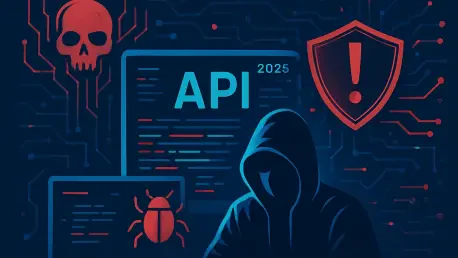In the rapidly evolving digital landscape of today, a staggering reality has emerged for enterprises worldwide: Application Programming Interfaces (APIs) have become the most exploited entry point for cybercriminals. As businesses increasingly rely on APIs to connect systems, automate processes, and power innovative technologies, the attack surface has expanded dramatically. Recent data reveals that API-related vulnerabilities and exploits are not only on the rise but are being targeted with unprecedented sophistication. This alarming trend, driven by misconfigurations, logical flaws, and the integration of artificial intelligence (AI), poses a significant challenge to cybersecurity professionals. With attackers shifting focus to these critical interfaces, understanding the scope of the threat and adapting defenses accordingly has never been more urgent. The implications of failing to secure APIs are profound, as breaches can compromise sensitive data and disrupt entire operations with minimal effort from malicious actors.
Emerging Threats in API Security
Surge in API Vulnerabilities
The volume of API-related vulnerabilities has seen a sharp increase in recent quarters, signaling a growing interest from threat actors. According to detailed reports, a notable 9.8% rise in Common Vulnerabilities and Exposures (CVEs) tied to APIs occurred between the first and second quarters of this year, reaching a total of 639 unique issues in Q2 alone. This spike highlights how APIs have become a focal point for exploitation, as they often serve as the connective tissue between applications and services. Unlike traditional software flaws, many of these vulnerabilities stem from misconfigurations or inherent design oversights rather than outdated code. Attackers exploit these weaknesses to gain unauthorized access or manipulate system behavior, often with devastating consequences. As enterprises expand their digital footprints, the sheer number of APIs in use multiplies, creating more opportunities for errors to be exploited. This trend underscores the need for heightened vigilance and more robust security frameworks to address the escalating risks.
AI-Driven API Risks
Another critical dimension of the API threat landscape is the intersection with AI technologies, which has introduced a new layer of complexity. Vulnerabilities specific to AI-serving endpoints and orchestration frameworks nearly doubled in a single quarter, jumping from 19 to 34 identified issues. This rapid escalation reflects the growing reliance on AI-powered systems within enterprise environments, where APIs play a pivotal role in data exchange and automation. Attackers are increasingly targeting these endpoints to manipulate AI models or extract sensitive information, exploiting the trust placed in automated processes. The convergence of API and AI security challenges represents a frontier that many organizations are unprepared to defend against, as traditional safeguards often fall short in addressing these nuanced risks. As AI adoption accelerates, securing the associated APIs becomes a non-negotiable priority to prevent cascading failures across interconnected systems.
Exploitation Trends and Real-World Impacts
Beyond sheer numbers, the nature of API exploitation has evolved, with attackers employing sophisticated methods to capitalize on systemic weaknesses. Data from the CISA Known Exploited Vulnerabilities (KEV) catalog indicates that 22% of confirmed in-the-wild attacks during Q2 were linked to API flaws, with tactics like unauthenticated access, Broken Object Level Authorization (BOLA), and injection attacks leading the charge. High-profile incidents at major corporations have demonstrated the ease with which attackers can orchestrate breaches through exposed endpoints, often using a single HTTP request to inflict widespread damage. These cases serve as stark reminders of the consequences of neglecting fundamental security practices. The ripple effects of such breaches extend beyond immediate data loss, eroding customer trust and incurring significant financial penalties. As attackers refine their approaches, the urgency to address these exploitation patterns intensifies for organizations across industries.
Strategies to Mitigate API Threats
Rethinking Security Beyond Perimeters
Addressing the escalating threats to APIs requires a fundamental shift in how security is approached, moving away from outdated perimeter-based models. With the proliferation of cloud services, SaaS platforms, and external partnerships, the notion of a secure internal environment has become obsolete. Development environments, often assumed to be isolated, are frequently as exposed as production systems, making them prime targets for exploitation. Experts emphasize the importance of achieving full visibility into API ecosystems to identify potential vulnerabilities before they are exploited. This involves mapping out every API interaction and understanding the interconnected nature of modern systems. By adopting a zero-trust mindset, organizations can ensure that every access point is rigorously authenticated and authorized, minimizing the risk of unauthorized entry. This proactive stance is essential to safeguarding critical infrastructure in an era where traditional boundaries no longer apply.
Comprehensive Protection Measures
A multi-layered strategy is vital to counter the sophisticated threats targeting APIs, particularly those intertwined with AI components. Hardening authentication and authorization mechanisms stands as a foundational step, ensuring that only legitimate users can interact with sensitive endpoints. Beyond this, securing the AI stack—encompassing models, data pipelines, and serving APIs—requires specialized attention to prevent manipulation or data leakage. Combining API security testing with inline runtime protection offers a dynamic defense, enabling real-time detection and mitigation of threats as they emerge. Additionally, rigorous testing that goes beyond surface-level schema checks is necessary to uncover hidden logic flaws that attackers often exploit. By integrating these measures, enterprises can build a resilient security posture that adapts to the evolving tactics of cybercriminals. This holistic approach not only addresses current vulnerabilities but also anticipates future challenges in the ever-changing digital landscape.
Lessons Learned and Future Safeguards
Reflecting on the breaches and vulnerabilities that marked recent quarters, it became evident that organizational blind spots played a significant role in amplifying risks. Many companies underestimated the exposure of internal tools, leaving them vulnerable to external access through interconnected systems. High-profile incidents served as critical wake-up calls, revealing the devastating potential of simple oversights like unauthenticated endpoints. Moving forward, the focus shifted to actionable solutions that fortified defenses across the board. Implementing continuous monitoring and adopting advanced security tools proved effective in identifying threats early. Strengthening collaboration between development and security teams also emerged as a key step, ensuring that API design prioritizes safety from the outset. As the threat landscape continued to evolve, investing in ongoing education and adaptive strategies remained paramount to staying ahead of attackers and protecting digital assets for the long term.









